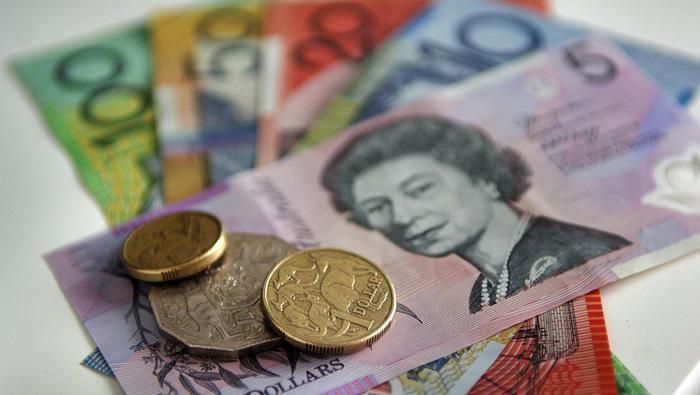2024-04-23 11:30
Gold (XAU/USD) Price and Analysis The precious metal falls sharply as risk assets rally during Israel-Iran conflict lull. US Q1 GDP and Core PCE data will drive price action later this week. Most Read: Understanding Inflation and its Global Impact The recent lull in the Israel-Iran conflict is giving risk assets a slight boost and drawing attention away from haven assets including gold. This week’s Passover (Pesach) religious holiday has quietened hostilities between the two countries, leaving haven assets on the sidelines, for now at least. Gold has rallied sharply on the recent risk off move and is giving back a small percentage of its recent gains as traders move into riskier asset classes. Later this week, three important US economic data releases will hit the screens and each of them has the ability to shift market momentum. While US Durable Goods is always worth noting, this week sees two heavyweight releases, the first look at Q1 GDP and the Fed’s preferred inflation gauge, Core PCE. US Q1 GDP is seen falling to 2.5% from a prior quarter’s 3.4%, a still robust number and one that will do little to change the Fed’s plans for rate cuts. A higher-than-forecast number however may push rate cuts back further. The Core PCE release is forecast to show core inflation falling further towards target, while headline inflation may tick up slightly. These numbers will be closely looked into and may well shift rate expectations, in the short term at least. Gold is now trading back under $2,300/oz. and is testing the 20-day simple moving average. A close and open below this indicator will leave gold vulnerable to further losses although the strength of the recent rally should see $2,800/oz. and $2,300/oz. act as reasonable levels of support. Below here $2,193 comes into focus but this level may be a stretch unless the conflict in the Middle East calms further. Learn How to Trade Gold with our Expert Guide Gold Daily Price Chart Chart via TradingView Retail trader data shows 54.89% of traders are net-long with the ratio of traders long to short at 1.22 to 1.The number of traders net-long is 4.10% higher than yesterday and 2.03% higher from last week, while the number of traders net-short is 10.85% lower than yesterday and 12.96% lower from last week. We typically take a contrarian view to crowd sentiment, and the fact traders are net-long suggests Gold prices may continue to fall. See the Full Report Below: What is your view on Gold – bullish or bearish?? You can let us know via the form at the end of this piece or you can contact the author via Twitter @nickcawley1. https://www.dailyfx.com/news/gold-s-surge-halted-as-risk-appetite-returns-us-economic-data-in-focus-20240423.html

2024-04-23 08:10
Japanese Yen (USD/JPY) Analysis Ueda, Suzuki address parliament on rates and the state of the yen USD/JPY respects 155.00 but the playbook suggests possible breach Short yen positioning adds to risks of a sharp reversal Major event risk: US GDP, PCE, BoJ meeting Elevate your trading skills and gain a competitive edge. Get your hands on the Japanese Yen Q2 outlook today for exclusive insights into key market catalysts that should be on every trader's radar: Ueda, Suzuki Address Parliament on Rates and the State of the Yen On Tuesday, the Bank of Japan (BoJ) Governor Kazuo Ueda and the Minister of Finance Shunichi Suzuki updated parliament on inflation, interest rates and measures to combat the continued yen weakness. Ueda, mentioned that rates will need to rise if trend inflation accelerates towards its 2% target as it expects. Friday’s meeting comes with the updated quarterly outlook and was initially eyed as the most likely opportunity for the Bank to raise rates out of negative territory. Having already hiked in March, the BoJ has had to take into account rising price pressures due, in part, to record wage growth, elevated oil prices, and a weaker yen - resulting in imported inflation. The market currently prices in a 10% chance the BoJ hike on Friday. The Japanese Finance Minister Shunichi Suzuki stressed that the recent trilateral meeting between Japan, South Korea and the US laid the groundwork for Japan to take ‘appropriate action’ in the currency market. At a post-cabinet meeting news conference Suzuki said that authorities are not ruling out any options when it comes to recent volatile JPY moves that are not representative of fundamentals. Next week’s Golden Week holidays in Japan could represent a low liquidity environment if authorities were to directly intervene in the FX market but the potential outcome remains uncertain. USD/JPY Respects 155.00 But the Playbook Suggests Possible Breach USD/JPY continue to respect the level of resistance at 155.00 – the level referred to by former vice finance minister Watanabe as a level that is likely to see a direct response from finance officials. However, markets respected the 152.00 level in a similar way before US CPI provided the catalyst to power through the psychological barrier. This week, we have another inflation print in the form of PCE data that may act as a bullish catalyst again, potentially sending the pair higher. The RSI remains in overbought territory but a strong dollar and lackluster yen suggests this may extend for some time to come. The interest rate differential between the two keeps the carry trade alive and well -adding to the recent yen pressure as markets delay the first Fed cut even further down the line. USD/JPY Daily Chart Source: TradingView, prepared by Richard Snow Learn the ins and outs of trading USD/JPY - a pair crucial to international trade and a well-known facilitator of the carry trade Short Yen Positioning Adds to Risks of a Sharp Reversal Large speculative institutions like hedge funds and other money managers collectively hold a massive amount of short yen positions that could be unwound very quickly. The ‘smart money’ as they’re often referred to are clearly positioned to benefit from the positive carry but any FX intervention from Tokyo carries the potential for massive volatility and a sharp move lower in USD/JPY. Previous cases if intervention saw around 500 pip moves in the immediate aftermath. Commitment of Traders (CoT) Report Showing Yen longs, shorts and USD/JPY (inverted) Source: TradingView, prepared by Richard Snow Major Risk Events for the Remainder of the Week US data welcomes a return to prominence this week with the first look at US first quarter GDP on Thursday before Friday’s busy end to the week with US PCE inflation data and the Bank of Japan rate announcement. The Atlanta Fed’s GDPNow forecast puts US GDP at 2.9% in Q1 versus the estimate of 2.5%. Either way, the data would represent moderating growth in the US but the economy remains strong on a relative basis – compared to the UK and EU, for example. The Bank of Japan is set to release its updated quarterly outlook report at Friday’s meeting with a focus on the banks medium term inflation outlook taking into account record wage growth, elevated oil prices (Japan is a net-importer of oil) and a weaker yen all potentially adding to the data point – supporting further BoJ hikes to come. PCE inflation data is the next data point in what has proven to be a series of hotter prints since the start of the new year. The expectation of 2.6% suggests hotter inflation is expected to continue and a large focus will be directed towards the month-on-month figure for a better idea of recent price pressures. Stay up to date with breaking news and themes driving the market by signing up to out weekly DailyFX newsletter: https://www.dailyfx.com/news/yen-alert-suzuki-stresses-trilateral-support-ahead-of-golden-week-20240423.html

2024-04-22 20:00
Multi-Asset Analysis (Gold, Silver, S&P 500) Gold overheats, lets off some steam at the start of the week Silver drops after testing resistance zone S&P 500 gaps higher but looks to tech earnings for bullish catalyst The analysis in this article makes use of chart patterns and key support and resistance levels. For more information visit our comprehensive education library Gold Overheats, Lets off Some Steam at the Start of the Week This week has started in a similar fashion to how we closed out last week, with a pick up in risk appetite as the tit-for-tat exchanges between Israel and Iran appears to have come to an end. Numerous markets breathe a sigh of relief, such as: gold, silver, AUD and US equities. The Aussie dollar often moves in line with risk assets and revealed a partial recovery since Friday afternoon, extending into today. For a more in-depth analysis, read the full AUD report. Until Friday, gold rode the bullish momentum higher, spurred on by additional safe haven appeal. That same appeal appears to have subsided at the start of this week, with the precious metal on track for the largest single day decline since the 9th of March 2022. Implied gold volatility has also turned notably lower as markets reduce the likelihood of a broader conflict in the Middle East. 30-Day Implied Gold Volatility (GVZ) Source: TradingView, prepared by Richard Snow Gold market trading involves a thorough understanding of the fundamental factors that determine prices like demand and supply, as well as the effect of geopolitical tensions and war. Find out how what lies ahead by reading our comprehensive Gold Q2 forecast : Gold has struggled to approach the new all-time high around $2341, apart from the Friday push, and has traded sharply lower on Monday. The next level of support for the yellow metal appears at $2319.50 ($2320), which could indicate a deeper pullback towards $2222. Gold has been trading within overbought territory for an extended period of time and has finally recovered into a more ‘normal’ range. Gold has proven to be impervious to a stronger US dollar as well as US Treasury yields, but now that risk appetite appears to have lifted, will the non-yielding metal begin to feel the effects. Additionally, robust US data has led the market to push out rate cuts later in the year, something that is likely to keep the greenback supported, weighing on gold. Gold (XAU/USD) Daily Chart Source: TradingView, prepared by Richard Snow Similarly, silver has seen a notable decline on Monday. As a result, the move can even be seen on the weekly chart and it’s only the first day of the week. Silver prices have found resistance around the zone of resistance at $28.40, now trading below the 78.6% Fibonacci retracement of the 2021-2022 major decline. Further bearish momentum would highlight the $26.10 level which previously acted as a robust level of resistance, followed by the 61.8% Fibonacci retracement at $25.30. Silver (XAG/USD) Weekly Chart Source: TradingView, prepared by Richard Snow S&P 500 Gaps Higher but Looks to Tech Earnings for a Bullish Catalyst The volatility index (VIX), in the grander scheme of things, has hardly lifted from basement levels when viewed on a large time frame (monthly chart below). The VIX is widely viewed as a fear index, rising when equity markets sell-off. The VIX is already heading lower despite the S&P 500 registering its deepest pullback since the start of the end of October last year. Earnings season is hitting its stride in the US, with major tech stocks due to post earnings updates this week. Some of those big names include Tesla, Meta, Alphabet and Microsoft. Volatility Index (VIX): 30-Day Implied Volatility Derived from the S&P 500 Source: TradingView, prepared by Richard Snow The S&P 500 has retraced more than 5% from its peak but gapped higher at the open on Monday to trade just shy of the psychological 5000 mark. A hawkish admission from the Fed’s John Williams and still robust US data has delayed Fed rate cuts. In fact, Williams put a potential hike on the list of probabilities when addressing the recent uptick in inflation since the start of the year. A large part of the bull run was fueled by the broad anticipation of multiple rate cuts in 2024, but the landscape looks very different now with markets not even pricing in two full rate cuts from the Fed. The Fed also prefers to stress their independence from politics and steers clear of rate adjustments during presidential elections – meaning realistic opportunities to cut rates are becoming fewer. AI-focused stocks like Microsoft will be under the microscope this earnings season as the AI story was an integral part of the bullish run. Positive earnings reports combined with optimistic forward guidance may be required to re-invigorate US stocks towards the 50-day SMA, while a further decline brings the prior all-time high of 4818 into focus. S&P 500 Daily Chart Source: TradingView, prepared by Richard Snow Stay up to date with the latest breaking news and themes driving the market by signing up to the DailyFX weekly newsletter https://www.dailyfx.com/news/risk-sentiment-snapshot-gold-silver-and-s-p-500-price-action-20240422.html

2024-04-22 17:00
Japanese Yen USD/JPY and GBP/JPY Prices, Charts, and Analysis USD/JPY – US data and BoJ policy decisions may make or break USD/JPY this week. GBP/JPY – Weak Sterling sees GBP/JPY reject resistance. Most Read: USD/JPY Latest: Trilateral Meeting Hints at Co-ordinated Intervention Effort The Bank of Japan will announce its latest monetary policy decision on Friday, and while the central bank is fully expected to leave all policy settings untouched, as with all central bank meetings, post-decision commentary is key. Current financial market expectations are showing just a 10% probability of a 10 basis point rate hike and unless the BoJ gives the market something to work with, and not just talk about following the exchange rate closely, the Japanese Yen is set to remain weak. This week also sees three important US data releases, durable goods, the first look at Q1 GDP, and the latest Core PCE reading. US growth is seen slowing, but remains robust, while a move in Core PCE will give the Federal Reserve some wiggle room for one or possibly two rate cuts later this year. The US dollar is pushing higher today and is looking set to post a fresh multi-month high. US Treasury yields remain elevated and will stay that way this week as $183 billion of combined 2s, 5s, and 7s hit the street. In addition, the Euro continues to slip lower, while Sterling is under pressure on renewed rate cut hopes. The Euro (57.6%) is the largest component of the dollar index, while the British Pound (11.9%) is the third-largest. If the dollar index breaks last week’s 106.58 high, the October 2nd print at 107.33 becomes the next level of resistance. US Dollar Index Daily Chart According to market thoughts, including ours, the 155.00 is the line in the sand for USD/JPY before official intervention is seen. This level now looks increasingly vulnerable due to recent US dollar strength. The technical outlook also looks bullish and a break above could see the pair move to 156.00 or 157.00 with speed. A difficult pair to trade currently with the BoJ/MoF looking on with great interest. Learn How to Trade USD/JPY with our Free Guide USD/JPY Daily Price Chart The recent GBP/JPY sell-off is nearly all due to Sterling weakness as BoE rate expectations are pulled in. After battling with the 192-193 area for the best part of this month, recent Sterling weakness has seen the pair drop to around 190.50. A break below 190.00 will bring the 188.80 area into play before 186s act as support. This year’s series of higher lows remains intact, and the series of higher highs looks to be broken. GBP/USD, EUR/GBP Outlooks – Sterling Weakens After Bank of England Commentary GBP/JPY Daily Price Chart What is your view on the Japanese Yen – bullish or bearish?? You can let us know via the form at the end of this piece or you can contact the author via Twitter @nickcawley1. https://www.dailyfx.com/news/japanese-yen-latest-usd-jpy-and-gbp-jpy-technical-analysis-and-outlooks-20240422.html

2024-04-22 13:30
Euro (EUR/USD) Talking Points: EUR/USD closes in on 5-month lows Eurozone rates are now expected to fall before those in the US For as long as that’s the case, the Euro is going to struggle Elevate your trading skills and gain a competitive edge. Get your hands on the Euro Q2 outlook today for exclusive insights into key market catalysts that should be on every trader's radar: The Euro was just a little weaker against the United States Dollar on Monday, with the pace of its fall slowing. That may not be the case for long, however. Monetary policy differentials remain strongly in the greenback’s favor, leaving the Euro on the ropes. The lack of serious escalation in tensions between Israel and Iran has seen risk appetite perk up a little, sending the Dollar broadly if only marginally lower. The Euro has benefitted from this, but Middle-Eastern geopolitics remain extremely fluid and this is not reliable respite. More broadly, the Euro continues to suffer from the clear chance that the European Central Bank will be cutting interest rates in June, on present showing long before the Federal Reserve follows it down that path. US inflation has clearly been more resilient than anyone expected at the start of this year, with stronger overall economic growth also arguing the Dollar’s case against the single currency. This week’s major scheduled trading point is likely to come from the USD side of things. Inflation data from the Personal Consumption and Expenditure series are due on Friday. This is known to be the Fed’s preferred pricing gauge, so it has naturally become the markets’ too. March core inflation is expected to have relaxed to 2.6% from 2.8%. Any upside surprise would be a serious problem for Euro bulls. There are some important European data releases before this one, notably Germany’s Purchasing Managers Index and the Ifo business climate snapshot. However, moves on these are likely to be limited by the wait for PCE. EUR/USD Technical Analysis The Euro has plummeted far below its medium-term downtrend line, 200-day moving average and its previous trading band and now languishes close to five-month lows. The key question now is whether the narrower trading ranges seen in recent days amount to signs of a bullish fightback or mere respite for an oversold market on the road lower. While the latter must be more likely, the fate of two important retracement levels will probably be good near-term signposts. EUR/USD Daily Chart Compiled Using TradingView Current falls have notably stopped just before the 1.05950 level which marks the firth Fibonacci retracement of the rise to December’s highs from the lows of early October. Bears will need to force the pace below this level if they are to negate the entire rise. To the upside lies the fourth retracement at 1,07101. This gave way during April 12’s sharp falls and has not come close to being reclaimed since. Just ahead of that, bulls would need to retake February 14’s intraday low of 1.06962 if they are going to power back above that level. --By David Cottle for DailyFX https://www.dailyfx.com/news/eurusd-steadies-as-market-looks-ahead-to-key-us-inflation-numbers-20240422.html

2024-04-22 11:34
Aussie Dollar (AUD/USD, AUD/NZD) Analysis Geopolitical tensions cool, allowing AUD limited room to recover AUD/USD shows signs of recovery but technical headwinds remain AUD/NZD bull flag emerges as the pair recovers from overbought territory Elevate your trading skills and gain a competitive edge. Get your hands on the Aussie dollar Q2 outlook today for exclusive insights into key market catalysts that should be on every trader's radar: Geopolitical Tensions Cool, Allowing AUD Limited Room to Recover In the early hours of Monday morning, the risk-aligned Australian Dollar attempted to claw back losses that developed early on Friday after reports of an Israeli strike in Iran. The tit-for-tat conflict appears to be over now that Iranian officials stand by their view that Israel has already received its response. Before the relative calm, FX markets revealed a preference for safe haven currencies, something that has revealed a full reverse in the early hours of trading on Monday. As a result the Australian dollar has perked up against the US dollar and attempts to build on Friday’s gain against the Kiwi dollar. Major Currency Performance Overnight (Eastern Standard Time) Source: Financial Juice, prepared by Richard Snow A calmer geopolitical backdrop may allow limited room for an AUD recovery but US GDP and PCE data on Thursday and Friday, respectively, could weigh on risk assets towards the end of the week. Robust growth, jobs and inflation data led to a hawkish repricing in the Fed funds rate which may gain momentum if we see further surprises in the data later this week – supporting USD. On Wednesday, Australian inflation data for Q1 is expected to reveal another decline, from 4.1% to 3.4% which may leave AUD vulnerable ahead of the high impact US data. AUD/USD Shows Signs of Recovery but Technical Headwinds Remain The sharp rejection at 0.6365 provides the basis for today’s shorter-term recovery, now that the immediate threat of continued Israeli-Iran conflict has dissipated, and it would appear neither side are motivated to continue the direct exchanges. The improved risk sentiment buoys the Aussie dollar for now, with 0.6460 the immediate level of resistance standing in the way of a further charge towards the 200-day simple moving average (SMA), currently around 0.6530. Longer-term AUD/USD upside potential appears in doubt after comments from Fed Deputy Governor John Williams explicitly put rate hikes on the table, should data necessitate such a response. Implied probabilities derived from Fed funds futures reveals that the market is growing less confident around multiple Fed rate cuts this year; and with the central bank unlikely to alter rates around the election, the window for additional cuts is closing. AUD/USD Daily Chart Source: TradingView, prepared by Richard Snow AUD/NZD Bull Flag Emerges as the Pair Recovers from Overbought Territory AUD/NZD has consolidated lower in the month of April after the massive bull run, which gathered pace in late February. In early trading on Monday, price action is fairly flat, attempting to test the upper bound of the downward sloping channel. The channel functions as a potential bull flag for a bullish continuation, potentially. The bullish bias remains constructive as long as prices remain above 1.0885 – the early November 2022 swing low which has capped previous advances. The 50 and 200-day simple moving averages converge, opening up the possibility of a bullish crossover – a typically bullish signal. One criticism of the moving average crossover is it regarded as a lagging indicator and can simply exist as confirmation of what has already transpired. A cluster of prior highs around 1.0833 coincides with the bottom of the bull flag and represents the area of interest for AUD/NZD bears should the market trade lower from here. AUD/NZD Daily Chart Source: TradingView, prepared by Richard Snow Stay informed about breaking news and themes driving the market by subscribing to our weekly DailyFX newsletter https://www.dailyfx.com/news/aussie-dollar-outlook-sentiment-reversal-fuels-aud-recovery-20240422.html
